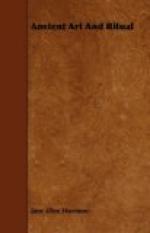The object of this book, as stated in the preface, is to try to throw some light on the function of art, that is on what it has done, and still does to-day, for life. Now in the case of a complex growth like art, it is rarely if ever possible to understand its function—what it does, how it works—unless we know something of how that growth began, or, if its origin is hid, at least of the simpler forms of activity that preceded it. For art, this earlier stage, this simpler form, which is indeed itself as it were an embryo and rudimentary art, we found to be—ritual.
Ritual, then, has not been studied for its own sake, still less for its connection with any particular dogma, though, as a subject of singular gravity and beauty, ritual is well worth a lifetime’s study. It has been studied because ritual is, we believe, a frequent and perhaps universal transition stage between actual life and that peculiar contemplation of or emotion towards life which we call art. All our long examination of beast-dances, May-day festivals and even of Greek drama has had just this for its object—to make clear that art—save perhaps in a few specially gifted natures—did not arise straight out of life, but out of that collective emphasis of the needs and desires of life which we have agreed to call ritual.
* * * * *
Our formal argument is now over and ritual may drop out of the discussion. But we would guard against a possible misunderstanding. We would not be taken to imply that ritual is obsolete and must drop out of life, giving place to the art it has engendered. It may well be that, for certain temperaments, ritual is a perennial need. Natures specially gifted can live lives that are emotionally vivid, even in the rare high air of art or science; but many, perhaps most of us, breathe more freely in the medium, literally the midway space, of some collective ritual. Moreover, for those of us who are not artists or original thinkers the life of the imagination, and even of the emotions, has been perhaps too long lived at second hand, received from the artist ready made and felt. To-day, owing largely to the progress of science, and a host of other causes social and economic, life grows daily fuller and freer, and every manifestation of life is regarded with a new reverence. With this fresh outpouring of the spirit, this fuller consciousness of life, there comes a need for first-hand emotion and expression, and that expression is found for all classes in a revival of the ritual dance. Some of the strenuous, exciting, self-expressive dances of to-day are of the soil and some exotic, but, based as they mostly are on very primitive ritual, they stand as singular evidence of this real recurrent need. Art in these latter days goes back as it were on her own steps, recrossing the ritual bridge back to life.
* * * * *
It remains to ask what, in the light of this ritual origin, is the function of art? How do we relate it to other forms of life, to science, to religion, to morality, to philosophy? These are big-sounding questions, and towards their solution only hints here and there can be offered, stray thoughts that have grown up out of this study of ritual origins and which, because they have helped the writer, are offered, with no thought of dogmatism, to the reader.




